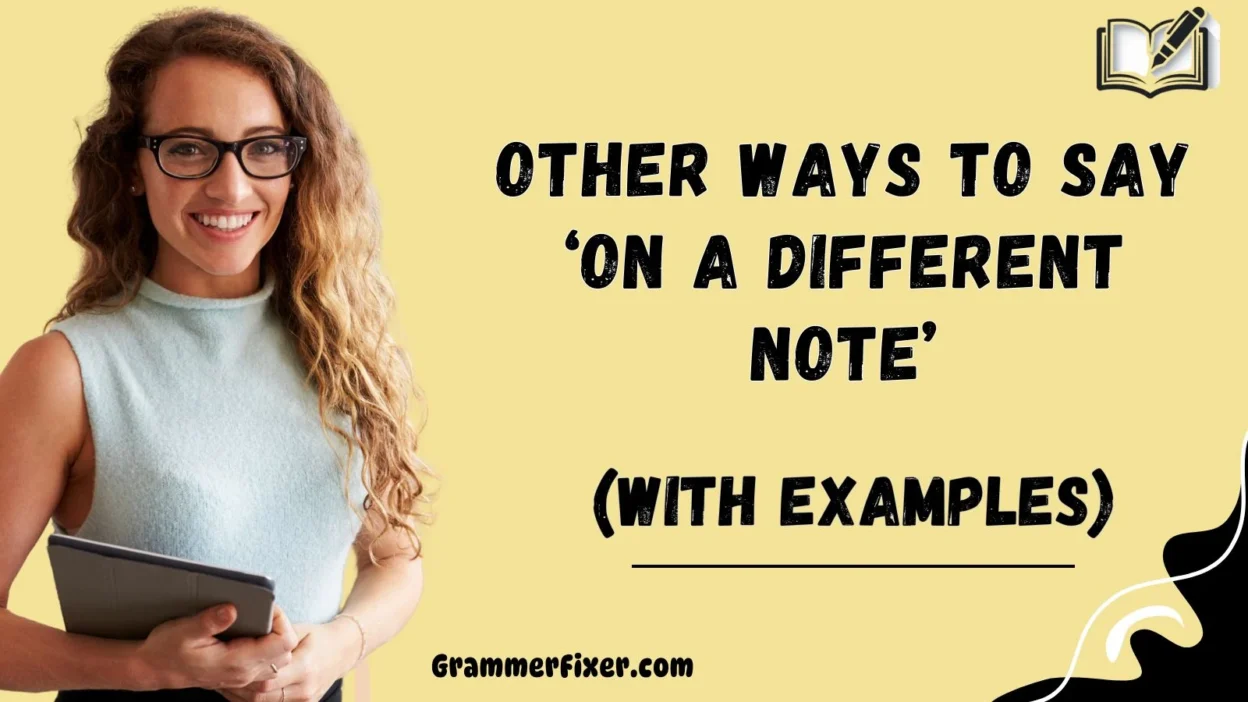Finding the right words can make a big difference in how we connect with others. Sometimes, a phrase like “On a different note” is used to gently shift the conversation, but it may feel too routine or overused. Having a variety of formal synonyms and alternatives allows us to express ourselves with more warmth, nuance, and care.
Whether in emails, meetings, or personal messages, the following expressions will help you sound more thoughtful, professional, and empathetic.
What Does “On a Different Note” Mean?
The phrase “On a different note” is used to transition from one topic to another, often to bring attention to a new subject that may be unrelated to what was previously discussed. It signals a shift in tone, focus, or perspective.
When to Use “On a Different Note”?
You might use it when:
- Changing topics in an email or conversation.
- Shifting focus from a completed discussion to a new one.
- Introducing unrelated information without sounding abrupt.
- Softening transitions in both professional and personal contexts.
Is It Professional/Polite to Say “On a Different Note”?
Yes. It’s generally seen as polite and professional, but in formal writing or academic communication, there may be more sophisticated synonyms that sound polished, precise, and considerate.
Pros or Cons
Pros
- Polite way to signal a change in discussion.
- Works in both formal and informal contexts.
- Keeps conversations smooth and organized.
Cons
- Can feel repetitive if overused.
- May sound a bit casual in high-level academic or business contexts.
- Alternatives may provide more clarity or nuance depending on tone.
1. In Another Context
Meaning: Suggests a change in perspective by moving discussion into a separate framework.
Detailed Explanation: This phrase indicates shifting from one angle of discussion to a new or distinct context, keeping the exchange professional.
Scenario Example:
- “In another context, the same policy might lead to different results.”
Best Use: Academic discussions, analytical writing.
Worst Use: Light-hearted or casual chats where it may sound overly rigid.
Tone: Professional, thoughtful.
2. Moving Forward
Meaning: Directs the conversation toward the next subject while implying progress.
Detailed Explanation: This is especially useful in business meetings to keep momentum without dismissing the prior point.
Scenario Example:
- “Moving forward, we should evaluate the financial projections.”
Best Use: Corporate reports, leadership communication.
Worst Use: Informal conversations with friends — it can sound bossy or corporate.
Tone: Motivational, structured.
3. Alternatively
Meaning: Offers another possibility or option instead of the previous subject.
Detailed Explanation: Often used in formal proposals or academic work, highlighting contrasts.
Scenario Example:
- “Alternatively, we could allocate the budget to research instead of marketing.”
Best Use: Proposals, written correspondence.
Worst Use: Social conversations — it may sound too technical or stiff.
Tone: Formal, precise.
4. From a Different Perspective
Meaning: Signals a shift to another viewpoint while still keeping relevance.
Detailed Explanation: Useful when exploring nuanced differences in thought.
Scenario Example:
- “From a different perspective, the data suggests another trend.”
Best Use: Research, strategy discussions.
Worst Use: Quick, casual discussions where a simpler phrase (“speaking of…”) works better.
Tone: Balanced, analytical.
5. In Contrast
Meaning: Highlights differences between the current subject and the new one.
Detailed Explanation: Often used to compare two topics directly.
Scenario Example:
- “In contrast, last year’s performance was considerably weaker.”
Best Use: Reports, presentations, formal papers.
Worst Use: Friendly notes or light emails — can sound blunt or argumentative.
Tone: Objective, comparative.
6. On Another Point
Meaning: Gently signals a new point without dismissing the prior one.
Detailed Explanation: Works in correspondence and conversation alike.
Scenario Example:
- “On another point, the client feedback has been very positive.”
Best Use: Professional emails, meetings.
Worst Use: Academic writing, where more precise transitions are preferred.
Tone: Neutral, polite.
7. Shifting Focus
Meaning: Acknowledges the transition directly.
Detailed Explanation: Best used to redirect attention in a clear and formal way.
Scenario Example:
- “Shifting focus, let’s review the upcoming deadlines.”
Best Use: Project updates, progress reports.
Worst Use: Sensitive conversations, where it may come across as dismissive.
Tone: Clear, directive.
8. In Another Vein
Meaning: Suggests a new but somewhat related topic.
Detailed Explanation: Useful when discussing connected ideas without being repetitive.
Scenario Example:
- “In another vein, customer engagement strategies are worth exploring.”
Best Use: Professional presentations, thoughtful conversations.
Worst Use: Everyday chat; it may sound old-fashioned or overly formal.
Tone: Elegant, formal.
9. On a Separate Matter
Meaning: Introduces a distinct subject, unrelated to the prior one.
Detailed Explanation: Helps segment business conversations or memos clearly.
Scenario Example:
- “On a separate matter, the team is finalizing the project proposal.”
Best Use: Internal memos, official updates.
Worst Use: Informal settings, where it may feel stiff or distant.
Tone: Direct, businesslike.
10. By Way of Transition
Meaning: Acknowledges the act of moving from one subject to another.
Detailed Explanation: Provides a formal bridge to ensure smooth communication.
Scenario Example:
- “By way of transition, let us review the company’s Q3 financial results.”
Best Use: Academic or formal speeches.
Worst Use: Emails with colleagues where simple language is enough.
Tone: Structured, polished.
11. With That Said
Meaning: Indicates a natural shift while connecting to the earlier point.
Detailed Explanation: Works as a conversational way to move forward while still honoring what came before.
Scenario Example:
- “With that said, we should also acknowledge the challenges ahead.”
Best Use: Friendly professional discussions, presentations.
Worst Use: Highly formal academic writing, where it can feel too casual.
Tone: Balanced, conversational.
12. Turning to Another Subject
Meaning: Redirects attention clearly to a new topic.
Detailed Explanation: Useful for steering structured conversations.
Scenario Example:
- “Turning to another subject, let’s discuss the client’s new proposal.”
Best Use: Meetings, structured correspondence.
Worst Use: Informal chats, as it may sound overly formal or stiff.
Tone: Direct, professional.
13. To Change the Subject
Meaning: A straightforward way to redirect the discussion.
Detailed Explanation: Works in both professional and casual settings when transparency is needed.
Scenario Example:
- “To change the subject, I’d like to update you on the policy revision.”
Best Use: Clear, open conversations.
Worst Use: Sensitive discussions, where it may seem abrupt or dismissive.
Tone: Honest, transparent.
14. On Another Note
Meaning: A close synonym of the original phrase, but still formal.
Detailed Explanation: Widely accepted in both spoken and written English as a polite transition.
Scenario Example:
- “On another note, we’re planning to expand our Asia-Pacific operations.”
Best Use: Professional and casual communication.
Worst Use: Overuse in formal documents, as it may feel repetitive.
Tone: Polite, flexible.
15. In Another Light
Meaning: Shifts the angle of discussion to a different interpretation.
Detailed Explanation: Often used to reframe ideas with nuance.
Scenario Example:
- “In another light, this change could be seen as an opportunity.”
Best Use: Academic discussions, strategy meetings.
Worst Use: Quick team updates, where it may sound too abstract.
Tone: Reflective, interpretive.
16. Redirecting Attention
Meaning: Directly states the act of moving focus elsewhere.
Detailed Explanation: Useful in reports, analysis, or structured updates.
Scenario Example:
- “Redirecting attention, let’s focus on customer feedback trends.”
Best Use: Formal meetings, structured presentations.
Worst Use: Social conversations, where it may sound mechanical.
Tone: Clear, directive.
17. With Respect to a Different Matter
Meaning: Signals a clear transition to a separate topic.
Detailed Explanation: Works well in business emails or legal contexts where precision matters.
Scenario Example:
- “With respect to a different matter, please review the updated policies.”
Best Use: Formal correspondence.
Worst Use: Casual or personal emails, where it feels stiff.
Tone: Polite, formal.
18. To Address Something Else
Meaning: Gently introduces a new focus for discussion.
Detailed Explanation: Adds clarity when moving on without dismissing what came before.
Scenario Example:
- “To address something else, the HR department will circulate the new appraisal guidelines.”
Best Use: Team updates, professional discussions.
Worst Use: Academic writing, where it sounds conversational.
Tone: Neutral, professional.
19. Speaking of Another Topic
Meaning: Moves the conversation by gently introducing a new subject.
Detailed Explanation: Creates a smoother segue than abrupt transitions.
Scenario Example:
- “Speaking of another topic, how is the new client onboarding process going?”
Best Use: Emails, meetings, casual-professional exchanges.
Worst Use: Highly formal documents.
Tone: Friendly, conversational.
20. In a Related but Separate Way
Meaning: Introduces something connected but distinct.
Detailed Explanation: Works when you want to show linkage yet distinction.
Scenario Example:
- “In a related but separate way, we should also evaluate customer feedback.”
Best Use: Analytical reports, professional discussions.
Worst Use: Casual chats, where it feels too wordy.
Tone: Careful, professional.
21. On an Entirely Different Point
Meaning: Marks a complete subject shift.
Detailed Explanation: Emphasizes strong distinction from the prior topic.
Scenario Example:
- “On an entirely different point, the finance team noted a dip in profits.”
Best Use: Reports, structured communication.
Worst Use: Friendly or informal conversations.
Tone: Formal, distinct.
22. To Shift the Conversation
Meaning: Explicitly declares a redirection.
Detailed Explanation: Best used to guide meetings with clarity.
Scenario Example:
- “To shift the conversation, let’s review Q4 strategies.”
Best Use: Project discussions, board meetings.
Worst Use: Informal chats, where it feels unnatural.
Tone: Professional, guiding.
23. Let Us Move to Another Subject
Meaning: A polite call to move to something else.
Detailed Explanation: Encourages a smooth group transition.
Scenario Example:
- “Let us move to another subject: the upcoming marketing campaign.”
Best Use: Team or client meetings.
Worst Use: Emails — it may feel overly formal in writing.
Tone: Courteous, formal.
24. In Another Direction
Meaning: Suggests steering the discussion differently.
Detailed Explanation: Works well for brainstorming and strategic contexts.
Scenario Example:
- “In another direction, what if we consider international partnerships?”
Best Use: Strategic meetings.
Worst Use: Strict academic papers, where precision is better.
Tone: Open, exploratory.
25. Focusing Elsewhere
Meaning: Declares redirection of attention.
Detailed Explanation: Helps prioritize new points without being abrupt.
Scenario Example:
- “Focusing elsewhere, our engagement metrics need closer evaluation.”
Best Use: Reports, structured emails.
Worst Use: Sensitive topics, where it could sound dismissive.
Tone: Direct, professional.
26. As Another Option
Meaning: Provides an alternative approach.
Detailed Explanation: Works well when suggesting choices.
Scenario Example:
- “As another option, we could delay the product launch until Q2.”
Best Use: Proposals, team decisions.
Worst Use: Irrelevant shifts (e.g., changing subject without connection).
Tone: Considerate, professional.
27. Considering a Different Angle
Meaning: Introduces a fresh perspective.
Detailed Explanation: Often used in analytical or strategic discussions.
Scenario Example:
- “Considering a different angle, customer feedback suggests another approach.”
Best Use: Reports, brainstorming sessions.
Worst Use: Informal notes, where it sounds overcomplicated.
Tone: Reflective, analytical.
28. Looking at a Separate Idea
Meaning: Moves to another concept while highlighting its uniqueness.
Detailed Explanation: Useful for creative or project discussions.
Scenario Example:
- “Looking at a separate idea, our campaign could include digital partnerships.”
Best Use: Creative meetings, planning.
Worst Use: Academic writing, where it feels vague.
Tone: Open, creative.
29. On an Unrelated Matter
Meaning: Acknowledges the subject is not connected to the last.
Detailed Explanation: Works well when bringing up distinct points.
Scenario Example:
- “On an unrelated matter, the HR team has adjusted appraisal schedules.”
Best Use: Memos, updates.
Worst Use: Sensitive conversations, where it may feel abrupt.
Tone: Neutral, direct.
30. Changing the Topic
Meaning: Straightforward phrase for moving away from a subject.
Detailed Explanation: Transparent and direct, but less formal.
Scenario Example:
- “Changing the topic, let’s focus on marketing performance.”
Best Use: Informal professional exchanges.
Worst Use: Academic writing or polished corporate reports.
Tone: Simple, casual-professional.
Conclusion
Language is more than just words — it’s how we show care, respect, and thoughtfulness in our communication. While “On a different note” is a useful and polite phrase, relying on it too often can feel repetitive or overly casual in professional or academic settings. That’s where these 30 formal synonyms step in — giving you the tools to transition smoothly, signal shifts clearly, and maintain warmth and precision in your tone.



